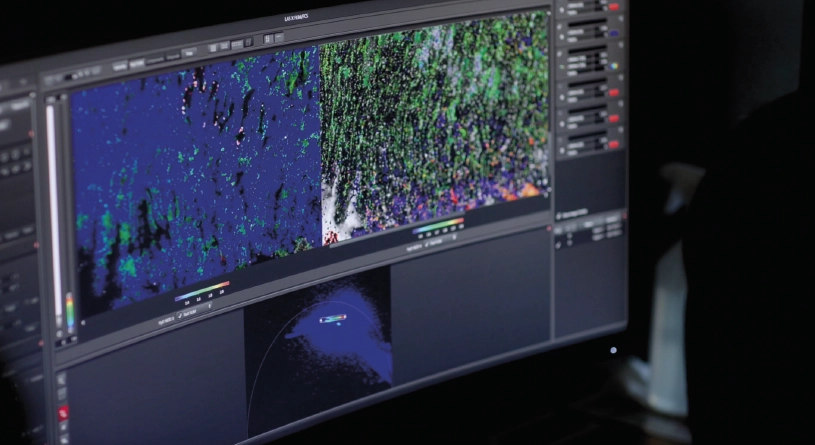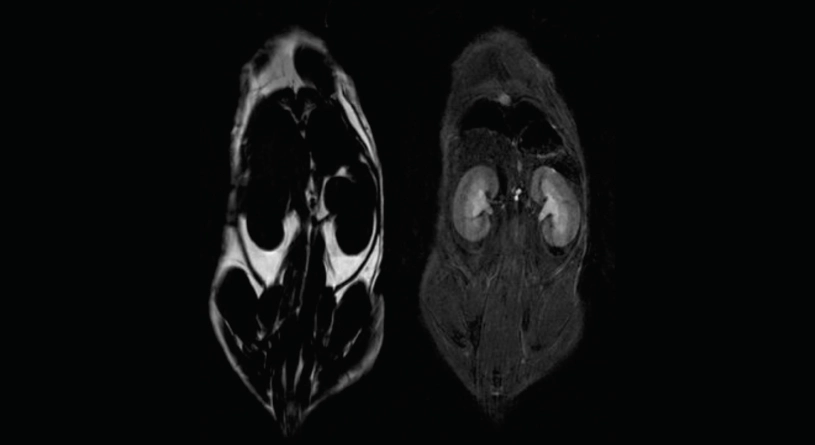Infrastructure for Advanced Translational Imaging (TRIMA) & ReDIBCutting-edge research to preserve knowledge

ReDIB, the Distributed Biomedical Imaging Network (www.redib.net), is a distributed Unique Scientific and Technical Infrastructure (ICTS) that depends on the Spanish Ministry of Science and Innovation. It consists of four nodes: TRIMA@CNIC, the Infrastructure for Advanced Translational Imaging at the Centro Nacional de Investigaciones Cardiovasculares Carlos III (CNIC); CIC biomaGUNE, the Molecular and Functional Imaging Platform of the Centre for Cooperative Research in Biomaterials; PREBI-GIBI230, the Infrastructure of La Fe University Hospital (Imaging La Fe); and BiolmaC, the bioimaging unit at Madrid’s Complutense University. The ICTS are large facilities, resources, equipment and services that are devoted to research and technological development, in addition to fostering the transmission, exchange and preservation of knowledge, technology transfer and innovation in Spain.
Their main objective is to make scientific and technical infrastructure and equipment available to the scientific, technological and industrial community both in Spain and internationally. These resources can be indispensable for conducting scientific and technological research that is unique or exceptional of its kind, which involves high costs in investment, maintenance and operation, but has a strategic nature and importance that justify their being accessible to the whole R&D&I collective.
All ICTS are unique and exceptional facilities of their kind. They conduct cutting-edge research of the highest quality and act as hubs for the transmission, exchange and preservation of knowledge and technology transfer as well as fostering innovation.
ICTS have three basic characteristics: they are publicly owned infrastructures, they are unique, and they are open via a competitive access process.
They are located at different points of Spain and can be seen on the Map of Unique Scientific and Technical Infrastructure. Depending on the level of integration and their capacities, ICTS may be a single-location infrastructure, form part of an ICTS network or be set up as a distributed ICTS, which is the case of ReDIB.
The ICTS map is dynamic and open, which means that the infrastructures included on the current map must continue to meet the necessary requirements to be an ICTS and, on the other hand, new infrastructures can be added as long as they are operational and prove compliance with the requirements.
The ICTS ReDIB has facilities that, in the opinion of external governmental evaluators, have unique characteristics that contribute to the singularity of the ICTS and are considered “essential”.
The essential installations at TRIMA@CNIC include Clinical PET-CT (Vereos digital positron emission tomography/computed tomography), clinical 3T MRI (Elition X3 magnetic resonance imaging), preclinical PET/SPECT/CT (trimodal system) and preclinical 7T MRI (Agilent-Varian).
The equipment, personnel and organisation of this facility form a dynamic group that provides a service to the scientific community in the field of molecular and functional imaging and advanced imaging. It includes state-of-the-art technologies and resources.
- TRIMA@CNIC, located at CNIC, has functioned since 2010. The facility has a translational vocation and state-of-the-art technologies to progress in the study of different diseases and cardiovascular conditions from molecular level to tissues; from preclinical research, principally with murine models, but also with human subjects.
- The Molecular and Functional Imaging Platform is part of CIC-biomaGUNE-San Sebastian. It was designed, built and equipped to conduct multimodal longitudinal research projects in the preclinical context, and to develop applications in the sphere of preclinical molecular and functional imaging and nanomedicine.
- BioImaC is a facility that belongs to Madrid’s Complutense University and consists of nuclear magnetic resonance, electron spin resonance, brain mapping and diagnostic imaging capabilities.
- The Medical Imaging Unit at the University and Polytechnic La Fe Hospital in Valencia, consists of the Biomedical Imaging Research Group, GIBI230, and PREBI, the Experimental Radiology and Biomarkers Imaging Unit, which have the mission of promoting and developing the use of imaging and biomarker techniques to optimise the diagnostic and therapeutic efficiency of medical imaging through a multidisciplinary, multimodal approach to healthcare research and experimentation with preclinical models.

The management body of ICTS has representatives from the four nodes that make up ReDIB, and a coordinator, Dr. Gonzalo Pizarro, CNIC clinical researcher and head of the Cardiology Service at Hospital Ruber Juan Bravo Quironsalud.
How to access ReDIB
Any researcher, whether Spanish or international, can access the facilities and services that are on offer via the website https://www.redib.net. All the facilities belonging to ICTS have the obligation to allot 20% of their time to external users via a competitive access process.
When a user generates a request that meets the conditions, the Coordinating Committee of representatives from the four nodes evaluates the technical feasibility of the request. Some requests are technically not viable and so cannot continue. The request must include a summary of the research project.
Last year, 17 projects gained access to the TRIMA@CNIC facility via the open competitive access calls, and 12 projects did so through the on-demand access process
If the project is feasible, it is forwarded to the Access Committee, a group 30 national and international experts. This independent, external committee evaluates the proposal and issues a report qualifying whether the project has sufficient scientific merit to receive approval and be conducted within the ICTS. It also establishes the project’s priority.
Once the call for projects has finalised, the applicant is informed.
ReDIB has three to four open competitive access calls each year; a form of access with logistic and financial advantages for the researcher who applies. It is also possible to access ReDIB through an on-demand request process. This year, the 4th call for applicants closed on 31st August 2023.
ReDIB equipment

Clinical imaging
ReDIB offers clinical imaging services at two of its nodes: CNIC and Imaging La Fe PREBI-GIBI230. TRIMA, the Infrastructure for Advanced Translational Imaging, has PET-CT equipment (Vereos digital positron emission tomography/computed tomography), a 3T MRI and echocardiography with 4D image acquisition.
https://www.redib.net/imagen-clinicaPreclinical imaging
The Molecular and Functional Imaging Platform at CIC-biomaGUNE has two magnetic resonance imaging (MRI) devices, hybrid PET-CT and SPECT-CT devices and an optical/X-ray imaging system. On the other hand, TRIMA has MRI, hybrid PET-CT imaging and fluorescence molecular tomography (FMT) imaging systems as well as luminescence and fluorescence tomography equipment. BioImaC has three magnetic resonance imaging (MRI) systems and a hybrid PET-CT device in addition to X-ray and ultrasound equipment. Finally, Imaging La Fe has a 3T MRI, a microPET-CT device and fluoroscopy equipment.
https://www.redib.net/imagen-preclinicaImaging analysis
Preclinical imaging: The preclinical imaging analysis platform, CIC-biomaGUNE, offers the computational infrastructure necessary to process and analyse images.
Clinical imaging
This includes analysis of the images acquired by echocardiography, magnetic resonance, PET and computed axial tomography equipment. Different software programmes exist for these analyses, both CNIC-developed and commercial software (i.e., EchoPac for echocardiography, QMASS for MRI, QLab-Philips for resonance, PET and CT). The staff responsible for the analysis at CNIC adapt the form and system of analysis for each study after direct consultation with the researcher.
Radiochemistry
ReDIB offers radiochemistry services at two of its nodes. CNIC’s Infrastructure for Advanced Translational Imaging has a radiochemistry lab with a shielded area, a 68Ge/68Ga generator associated with an automatic synthesis module and a fully equipped organic chemistry laboratory. CIC-biomaGUNE’s Molecular and Functional Imaging Platform has a radiochemistry laboratory.
The 2022 ICTS national call resulted in approval for inclusion of the following facilities and equipment at the TRIMA@CNIC node:
- A SPECT, PET and CT imaging laboratory, including the imaging tools (SPECT-CT equipment) and set-up of the radiochemistry laboratory necessary for the synthesis and characterisation of new SPECT radioactive tracers.
- The system acquired has three imaging modes (PET, SPECT and CT), which can be used to study three to four preclinical models simultaneously, increasing the unit’s capacity. It also provides improved image quality in cardiac synchronisation and/or respiratory studies.
- In 2022, 17 projects gained access to the TRIMA@CNIC facility via the open competitive access calls, and 12 projects did so through the on-demand access process.


This activity is part of the Aid RED2022-134467-I funded by MCIN/AEI/10.13039/501100011033 and the Aid ICT2021-006950 funded by MCIN and the European Union NextGenerationEU/PRTR. This activity is part of the Aid CEX2020-001041-S funded by MICIN/AEI/10.13039/501100011033. This activity is part of the Aid CEX2020-001041-S funded by MICIN/AEI/10.13039/501100011033.













